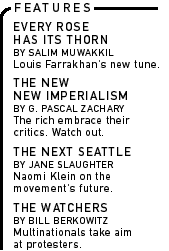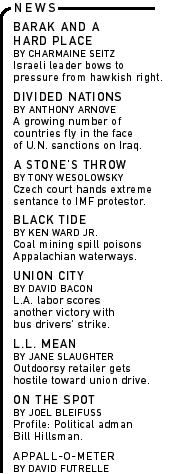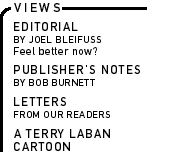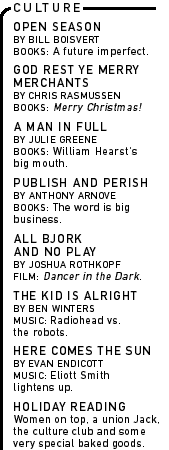
|

|

|

|

|
| |
|
|
|
Kid A The National Anthem"--the third song on what would have been, three or four formats ago, Side A of Radiohead's new record--almost fooled me into thinking that this album was written and performed by human beings from the planet Earth. It starts with a heavy fuzz bass riff, repeated twice before that first cymbal crash, and the song grooves and boogies (who gave Radiohead a horn section?) and defines its layers of internal melody just like a regular rock song. When I saw Radiohead perform it on Saturday Night Live, though they deployed their array of pedals and computers and synthesizers, it certainly appeared to be people turning the dials and jabbing at the buttons. But listen to Kid A closely and it's harder to say. The complex three-guitar landscapes
If Radiohead have been replaced by robot clones, they've done their homework. For all the departures of Kid A, Radiohead have never been a verse/ chorus/verse outfit. "Creep" was a pop song, yes, but it was a pop song like "Smells Like Teen Spirit" was a pop song. The lyrics rise and fall in intensity, the textures shift, but the chords stay the same throughout: G to B, a hesitant half-tone up to C, a desperate shift to C minor. "I'm not here / this is not happening / I'm not here," moans frontman Thom Yorke on "How To Disappear Completely," a moody march-tempo ballad midway through Kid A. Radiohead have won a cult following larger than most band's non-cult followings, and still they are poets of dissociation, still going on about not being where they are, about the struggle of the outsider: "Big fish eat the little ones / big fish eat the little ones / ... try the best you can / try the best you can." What's changed for Radiohead is their positioning in the cultural universe. They have entered that dangerous space for the avant-gardist, where enough people have signed on to their particular brand of eclecticism that they can afford to do what they feel like and remain confident that they will move product. This can be a license for self-indulgence (see Lou Reed's Metal Machine Music), an invitation to abandon better instincts and make dull masturbatory music. Red flags litter Radiohead's recent interviews, statements about "doing it differently or not doing it at all," avoiding "anything that smacked of the old route, or of being a rock 'n' roll band." After 1997's blockbuster OK Computer--harsh and menacing and electric, but undeniably rock 'n' roll--and the self-pitying promotional film Meeting People Is Easy, it sounded like Radiohead were morphing into what David Foster Wallace once called in a different context "the inward bound." All the more remarkable that Kid A is a such a fine piece of work, less immediately accessible then OK Computer but certainly as rewarding. Dense and marvelously complicated, Kid A shows all the signs of being a cohesive, careful work of art. It is at heart a beat record, an inspired combination of programmed and played percussion, propulsive and imaginative: Drummer Phil Selway has co-opted the encroaching computerization of his instrument with sophistication and good grace. Above the drums Kid A is richly textural, a layering of guitars and howls and blips. Each song builds up, establishes a particular energy and then floats away, ceding space to the next one. These songs are like weather systems: strange and intangible and beautiful, forceful and then suddenly serene. Kid A is not a lovable album, not an album for sing-alongs. The lyrics are often intangible, inscrutable, melting in and out of the ambience around them, rarely cresting into definable, isolated hooks. And when they do, Yorke is hitting those improbable super-high notes, the kind that make your vocal chords tighten and ache when you try them in the shower. He's like Wilco's Jeff Tweedy imagined by Philip K. Dick. Only with "Motion Picture Soundtrack," the warbling dirge that
closes out the album, does it start to feel like Radiohead have
run out of ideas. Besides, we know already that what we're listening
to is inherently visual, the sort of emotion-rich soundtrack music
that creates its own pictures, entirely distinct from what's on
the screen. Ben Winters is a playwright in Chicago.
|


